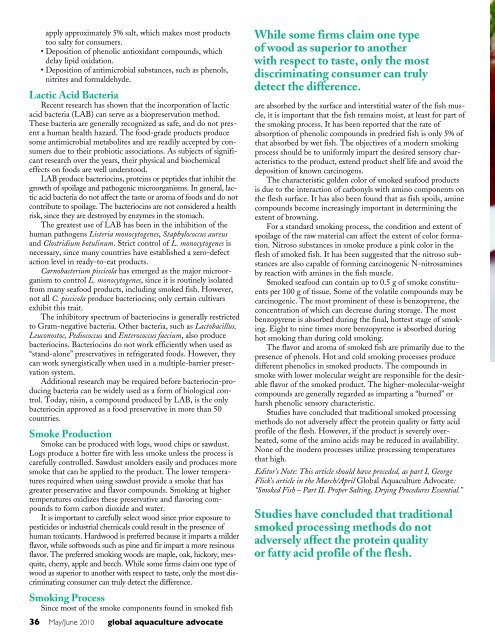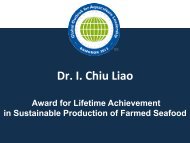May/June 2010 - Global Aquaculture Alliance
May/June 2010 - Global Aquaculture Alliance
May/June 2010 - Global Aquaculture Alliance
You also want an ePaper? Increase the reach of your titles
YUMPU automatically turns print PDFs into web optimized ePapers that Google loves.
apply approximately 5% salt, which makes most products<br />
too salty for consumers.<br />
• Deposition of phenolic antioxidant compounds, which<br />
delay lipid oxidation.<br />
• Deposition of antimicrobial substances, such as phenols,<br />
nitrites and formaldehyde.<br />
Lactic Acid Bacteria<br />
Recent research has shown that the incorporation of lactic<br />
acid bacteria (LAB) can serve as a biopreservation method.<br />
These bacteria are generally recognized as safe, and do not present<br />
a human health hazard. The food-grade products produce<br />
some antimicrobial metabolites and are readily accepted by consumers<br />
due to their probiotic associations. As subjects of significant<br />
research over the years, their physical and biochemical<br />
effects on foods are well understood.<br />
LAB produce bacteriocins, proteins or peptides that inhibit the<br />
growth of spoilage and pathogenic microorganisms. In general, lactic<br />
acid bacteria do not affect the taste or aroma of foods and do not<br />
contribute to spoilage. The bacteriocins are not considered a health<br />
risk, since they are destroyed by enzymes in the stomach.<br />
The greatest use of LAB has been in the inhibition of the<br />
human pathogens Listeria monocytogenes, Staphylococcus aureus<br />
and Clostridium botulinum. Strict control of L. monocytogenes is<br />
necessary, since many countries have established a zero-defect<br />
action level in ready-to-eat products.<br />
Carnobacterium piscicola has emerged as the major microorganism<br />
to control L. monocytogenes, since it is routinely isolated<br />
from many seafood products, including smoked fish. However,<br />
not all C. piscicola produce bacteriocins; only certain cultivars<br />
exhibit this trait.<br />
The inhibitory spectrum of bacteriocins is generally restricted<br />
to Gram-negative bacteria. Other bacteria, such as Lactobacillus,<br />
Leuconostoc, Pediococcus and Enterococcus faecium, also produce<br />
bacteriocins. Bacteriocins do not work efficiently when used as<br />
“stand-alone” preservatives in refrigerated foods. However, they<br />
can work synergistically when used in a multiple-barrier preservation<br />
system.<br />
Additional research may be required before bacteriocin-producing<br />
bacteria can be widely used as a form of biological control.<br />
Today, nisin, a compound produced by LAB, is the only<br />
bacteriocin approved as a food preservative in more than 50<br />
countries.<br />
Smoke Production<br />
Smoke can be produced with logs, wood chips or sawdust.<br />
Logs produce a hotter fire with less smoke unless the process is<br />
carefully controlled. Sawdust smolders easily and produces more<br />
smoke that can be applied to the product. The lower temperatures<br />
required when using sawdust provide a smoke that has<br />
greater preservative and flavor compounds. Smoking at higher<br />
temperatures oxidizes these preservative and flavoring compounds<br />
to form carbon dioxide and water.<br />
It is important to carefully select wood since prior exposure to<br />
pesticides or industrial chemicals could result in the presence of<br />
human toxicants. Hardwood is preferred because it imparts a milder<br />
flavor, while softwoods such as pine and fir impart a more resinous<br />
flavor. The preferred smoking woods are maple, oak, hickory, mesquite,<br />
cherry, apple and beech. While some firms claim one type of<br />
wood as superior to another with respect to taste, only the most discriminating<br />
consumer can truly detect the difference.<br />
Smoking Process<br />
Since most of the smoke components found in smoked fish<br />
36 <strong>May</strong>/<strong>June</strong> <strong>2010</strong> global aquaculture advocate<br />
While some firms claim one type<br />
of wood as superior to another<br />
with respect to taste, only the most<br />
discriminating consumer can truly<br />
detect the difference.<br />
are absorbed by the surface and interstitial water of the fish muscle,<br />
it is important that the fish remains moist, at least for part of<br />
the smoking process. It has been reported that the rate of<br />
absorption of phenolic compounds in predried fish is only 5% of<br />
that absorbed by wet fish. The objectives of a modern smoking<br />
process should be to uniformly impart the desired sensory characteristics<br />
to the product, extend product shelf life and avoid the<br />
deposition of known carcinogens.<br />
The characteristic golden color of smoked seafood products<br />
is due to the interaction of carbonyls with amino components on<br />
the flesh surface. It has also been found that as fish spoils, amine<br />
compounds become increasingly important in determining the<br />
extent of browning.<br />
For a standard smoking process, the condition and extent of<br />
spoilage of the raw material can affect the extent of color formation.<br />
Nitroso substances in smoke produce a pink color in the<br />
flesh of smoked fish. It has been suggested that the nitroso substances<br />
are also capable of forming carcinogenic N-nitrosamines<br />
by reaction with amines in the fish muscle.<br />
Smoked seafood can contain up to 0.5 g of smoke constituents<br />
per 100 g of tissue. Some of the volatile compounds may be<br />
carcinogenic. The most prominent of these is benzopyrene, the<br />
concentration of which can decrease during storage. The most<br />
benzopyrene is absorbed during the final, hottest stage of smoking.<br />
Eight to nine times more benzopyrene is absorbed during<br />
hot smoking than during cold smoking.<br />
The flavor and aroma of smoked fish are primarily due to the<br />
presence of phenols. Hot and cold smoking processes produce<br />
different phenolics in smoked products. The compounds in<br />
smoke with lower molecular weight are responsible for the desirable<br />
flavor of the smoked product. The higher-molecular-weight<br />
compounds are generally regarded as imparting a “burned” or<br />
harsh phenolic sensory characteristic.<br />
Studies have concluded that traditional smoked processing<br />
methods do not adversely affect the protein quality or fatty acid<br />
profile of the flesh. However, if the product is severely overheated,<br />
some of the amino acids may be reduced in availability.<br />
None of the modern processes utilize processing temperatures<br />
that high.<br />
Editor’s Note: This article should have preceded, as part I, George<br />
Flick’s article in the March/April <strong>Global</strong> <strong>Aquaculture</strong> Advocate:<br />
“Smoked Fish – Part II. Proper Salting, Drying Procedures Essential.”<br />
Studies have concluded that traditional<br />
smoked processing methods do not<br />
adversely affect the protein quality<br />
or fatty acid profile of the flesh.<br />
Cocktail hour<br />
Eastern Fish style.<br />
We propose a toast: Here’s to our customers the world over who rely on us for the<br />
freshest shrimp and seafoods available. We salute your discriminating taste, your<br />
insistence on quality, and your unwavering zeal for freshness. So here’s to you for<br />
helping make Eastern Fish Company one of the largest shrimp and seafood providers<br />
in the world. Bottoms up!<br />
global aquaculture<br />
f o u n d i n g m e m b e r<br />
Eastern Fish Company<br />
Glenpointe Centre East<br />
300 Frank W. Burr Blvd.<br />
Teaneck, New Jersey 07666<br />
1-800-526-9066<br />
Tel: 201-801-0800<br />
Fax: 201-801-0802<br />
easternfish.com<br />
®





